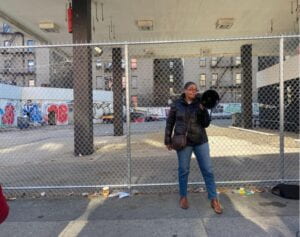As part of the Harlem Is Not For Sale movement, organizers are rejecting the typical income thresholds for their own affordable housing demands.

Under the metal gas station canopy, the winter breeze intensifies on a calm Saturday afternoon in late January. A small crowd of about 50 people gather, holding signs and speaking into megaphones at the vacant lot on 145th street, on what has become an increasingly contentious piece of land in Harlem. Local residents are here to protest a truck depot.
“Trucks emit harmful pollutants including nitrogen oxides, an ingredient of ground level ozone pollution, particulate matter, and black carbon. Air pollution is one of the most significant environmental threats to New Yorkers contributing to approximately 6% of deaths annually” said community member Gisele Camille into a megaphone as she read a letter from the attorney general demanding the owner of the lot to consider the environmental impact of the operation of a truck depot.
The opposition to the current use of the plot as a truck depot is the latest fight over controversial development in Harlem. In response, community activists with the Harlem is Not For Sale movement are designing their own criteria for what it takes to get their support for new projects.
The site on 145th street, sitting between Adam Clayton Powell Jr Boulevard and Lenox Avenue/Malcom X boulevard, has become the center of New York City’s most recent battle pitting residents against real estate. Since early 2022, a working class, multi-generation black and brown community had been pushing against the proposal of Bruce Teitelbaum, a real estate developer who owns the site on 145th street. Teitelbaum’s original proposal, known as One45, would have built two 363-foot residential towers and a civil rights museum. Some community organizers, supported by New York City council member Kristin Richardson Jordan (KRJ), opposed the development saying it had too few affordable housing units and would contribute to gentrification and displacement in the area.
With One45 pulled in the face of the resistance in city council, the owners decided to operate a Truck Depot on the site in the meantime. Tietelbaum argues that rejecting his plan produces no affordable housing – now his plot is being put to noxious use. Organizers say operating a commercial truck depot would only bring more environmental hazards in a region already experiencing traffic congestion and high rates of asthma and heart disease.
The rally against the truck depot is part of the community’s fight to rethink housing affordability standards beyond Area Median Income (AMI), the income thresholds used to determine eligibility for affordable housing. Area Median Income is calculated annually by the department of housing and urban development in metropolitan regions to determine affordable rent and who qualifies for it. In New York City, the area median income for a household of three is $120K. Community members opposed to the development consider AMI and the number of affordable units provided insufficient in addressing the community’s housing needs.
For more on Area Median Income (AMI), read Todd Baker’s proposed fix
The original proposal for One45 would have included 174 units designated to people earning 30% of New York City’s AMI, 164 units designated to people earning 60-80% of New York City AMI, and 120 units at an unspecified “affordable” level. All of which local residents, community activists and KRJ believe it is wholly unaffordable to local residents whose median household income is $36K and are severely rent burdened. However, the main problem community members had with the original One45 proposal is that only 220 of the project’s 850 residential units would have been permanently affordable, 650 units would have been market rent. This issue has catalyzed the community’s concerns over displacement of low-income, black and brown families who have lived in Harlem for generations. According to Census data, Harlem had lost 5,000 of its black residents over the last decade. Local residents who live and work near 145 street worry that a new development of this kind will push them out of their communities.
“This project was not going to be affordable to our community, to the black and brown people that have lived here for generations. Guess what else? It is not affordable for our children to live here,” said Giselle when asked about One45, “We need our seniors and those who are living on paychecks to be able to afford to live anywhere they want in Harlem.”

Countering One45’s original proposal, community members, alongside council member KRJ put forth an alternative contextual housing proposal. These contextual housing proposals, the plan says, respond to community demands, taking into account social, cultural and historical conditions of the neighborhood.
KRJ and the anti-gentrification task force in Harlem developed their own counter to AMI, an affordability measure that is fully based on their community’s income, family size, and needs. For example, a development like One45 would need to include 50% affordability aligning with the community’s income, rather than the proposed 12.3%. In the battle against One45, KRJ demanded 60% of units affordable to those making 54K or less annually, 30% of units for tenants making 28K or less, and a fifty-fifty split between total affordable and total market rate units.
Just what “affordable” means has been at the core of the housing debate. Harlem Is Not for Sale, is a long standing community-driven call to action. It tries to reframe the terms of housing affordability, placing social, economic and environmental justice concerns at the core of community demands from developers. More importantly, it hopes to push planners to acknowledge how the current affordability standards, while necessary in New York City, can miss the mark in communities like Harlem. As such, it invites planners and residents to rethink what housing solutions and housing justice could look like in New York City and beyond.
You can reach the author of this piece, Manal Bawazir, at: mb7086@nyu.edu
You can reach the editor of this piece, Patrick Spauster, at: ps4375@nyu.edu